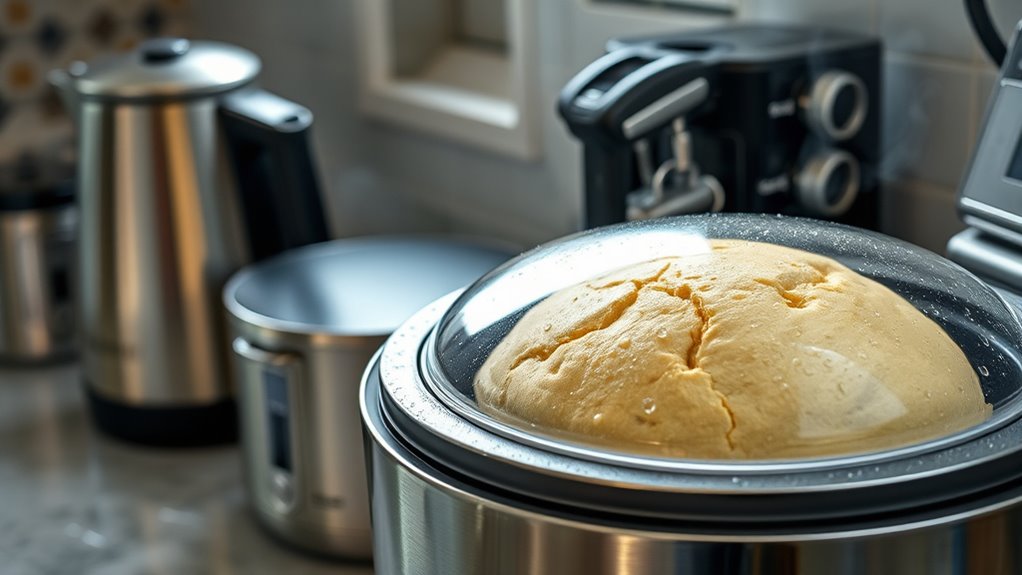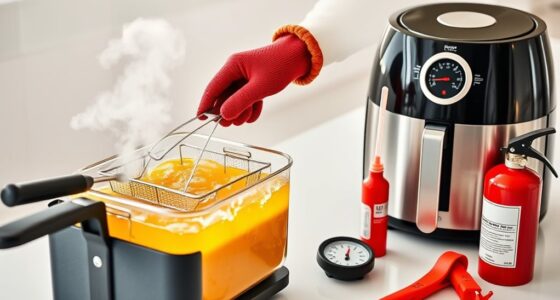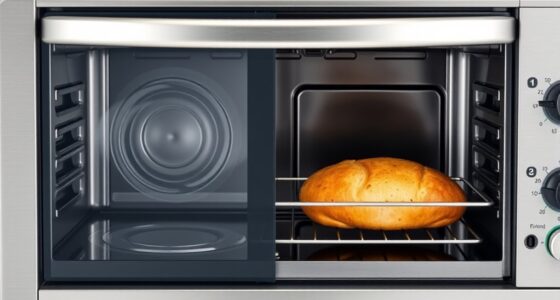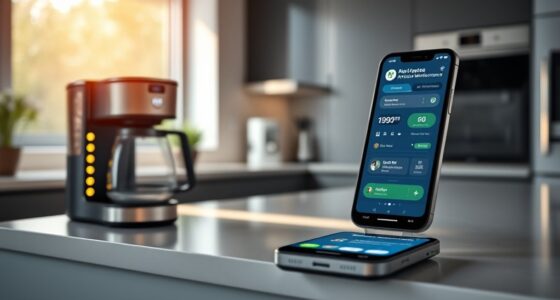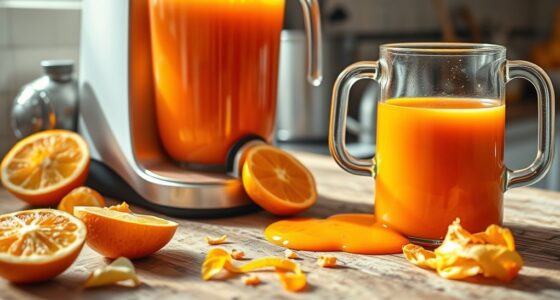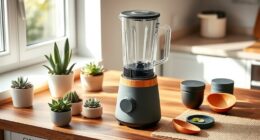Humidity levels can impact your bread maker and kitchen gadgets by affecting their performance and durability. High humidity makes dough sticky and hard to work with, while dry conditions can cause ingredients to clump or dry out, reducing effectiveness. Maintaining a balanced environment helps appliances operate smoothly and produces consistent results. Proper storage and environmental control are key, and if you stay aware of humidity’s effects, you’ll discover simple ways to optimize your baking experience.
Key Takeaways
- High humidity can cause bread maker components to malfunction or corrode due to moisture buildup.
- Excess moisture may lead to inconsistent dough kneading and rising, affecting baking quality.
- Low humidity can dry out ingredients and internal parts, reducing appliance lifespan and performance.
- Proper environmental control prevents moisture-related issues, ensuring accurate operation of kitchen gadgets.
- Using moisture-proof storage and humidity management tools maintains optimal functioning and extends device longevity.
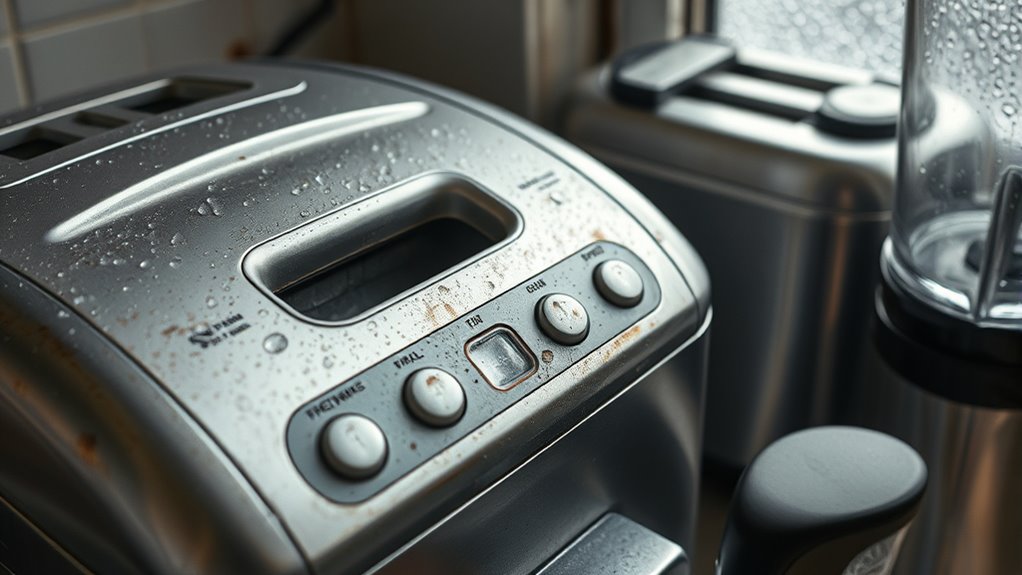
Humidity levels can markedly influence how your bread maker performs, especially when it comes to dough consistency and rising. If the air is too humid, your dough might become sticky and difficult to work with, while overly dry conditions can cause it to be dry, dense, and fail to rise properly. To keep your bread-making process smooth, you need to pay attention to humidity control, which involves managing the moisture content in your environment. Proper humidity control ensures your dough maintains the right moisture level, helping it rise evenly and develop the desired texture.
One of the simplest ways to handle humidity’s impact is through ingredient storage. Flour, yeast, and other baking ingredients are highly sensitive to moisture. When stored in humid environments, flour can absorb excess moisture, leading to clumping and uneven hydration when you mix your dough. Yeast, on the other hand, can become less effective if it absorbs too much humidity, which can compromise its ability to produce the carbon dioxide needed for rising. To prevent this, store ingredients in airtight containers in a cool, dry place. Using moisture-proof containers not only preserves the quality of your ingredients but also helps maintain consistent results in your bread making.
In addition to proper storage, you can adjust your workspace to control humidity levels. For example, if you’re in a particularly humid climate, running a dehumidifier nearby can help keep the air dry enough for ideal ingredient performance and dough handling. Conversely, if your environment is very dry, using a humidifier can add just enough moisture to prevent your dough from drying out during mixing and proofing.
Another tip is to measure the moisture content of your ingredients if you notice inconsistent results. Some bread makers come with moisture sensors or settings that can be adjusted based on the humidity conditions. If yours doesn’t, you can compensate by slightly reducing or increasing the amount of liquid in your recipes. Remember that the temperature and humidity of your kitchen are constantly changing, so being adaptable is key.
Additionally, understanding the impact of humidity on ingredient quality can help you make more informed adjustments and improve your baking results. Ultimately, managing humidity through proper ingredient storage and environmental control can greatly enhance your bread-making experience. By keeping your ingredients dry and adjusting your workspace to maintain steady humidity levels, you ensure your dough rises properly and results in a better loaf every time. Paying attention to these factors allows your bread maker to perform at its best, giving you bakery-quality bread with less guesswork and more confidence in your baking skills.
Frequently Asked Questions
How Does Humidity Affect the Longevity of Kitchen Gadgets?
Humidity can shorten the lifespan of your kitchen gadgets by promoting moisture corrosion and rust. When you don’t store your appliances properly, moisture builds up, leading to rust and damage over time. To prevent this, keep gadgets in dry, well-ventilated areas, wipe them down regularly, and consider using silica gel packs or rust prevention sprays. Proper maintenance helps extend their durability and keeps them functioning smoothly.
Are Certain Materials More Resistant to Humidity Damage?
Yes, certain materials are more resistant to humidity damage. You’ll find that stainless steel and high-quality plastics offer better moisture resistance and greater material durability compared to wood or lesser plastics. These materials help prevent rust, warping, and mold growth, ensuring your kitchen gadgets last longer. When choosing appliances, look for those made from moisture-resistant materials to keep your equipment in top shape despite humid conditions.
Can Humidity Levels Impact the Safety of Bread Making?
Humidity hinders safe handling when it hampers yeast, encouraging mold growth, and heightening health hazards. High humidity levels can cause yeast to ferment prematurely, risking unpredictable rising, while mold spores thrive in damp environments. You should control humidity to keep your kitchen safe, store ingredients properly, and prevent mold from multiplying. Maintaining a dry, cool environment minimizes microbial risks, ensuring your bread-making process remains safe, sanitary, and successful.
What Are the Best Storage Practices for Kitchen Appliances in Humid Environments?
You should place a dehumidifier nearby to reduce moisture in the air, especially in humid environments. Store your kitchen appliances in airtight storage containers to prevent humidity from causing rust and damage. Make sure to keep appliances in a cool, dry place, and regularly check for condensation. Proper dehumidifier placement and sealed storage help maintain your gadgets’ longevity and performance, protecting them from humidity-related issues.
Does Humidity Influence the Energy Efficiency of Kitchen Gadgets?
Humidity impact can turn your kitchen gadgets into energy vampires, making them work harder than ever. When humidity rises, moisture affects electrical components, increasing energy consumption and reducing efficiency. You might notice appliances running longer or using more power to perform the same tasks. To keep energy use in check, store gadgets in dry, well-ventilated spaces, and regularly maintain them to prevent humidity-related issues from draining your energy and wallet.
Conclusion
In summary, humidity plays a vital role in how your bread maker performs, affecting dough consistency and rising time. Did you know that in high humidity environments, bread can rise up to 20% faster? So, next time you’re baking, keep an eye on the moisture levels to make certain of perfect results. Staying aware of humidity helps you avoid over-proofing and guarantees delicious, fluffy bread every time.
